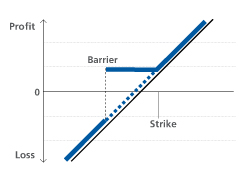Schnellzugriff
- Direkt zur Sitemap
- Direkt zur Suche
- Direkt zur Startseite
- Direkt zu Zugang für Alle
- Direkt zur Navigation
- Direkt zum Inhalt
- Direkt zum Kontakt

Product type number as specified by the Swiss Structured Products Association (SSPA): 1320
Please consult the termsheet and the accompanying issue prospectus for information on the exact product functionality, product details and risks.

| Scenario 1 | Scenario 2 | Scenario 3 | Scenario 4 | |
|---|---|---|---|---|
| Description | Rising underlying | Slightly rising underlying | Slightly falling underlying | Falling underlying |
| Underlying value | share X | share X | share X | share X |
| Term | 1 year | 1 year | 1 year | 1 year |
| Nominal amount | CHF 100 | CHF 100 | CHF 100 | CHF 100 |
| Bonus level | 110% | 110% | 110% | 110% |
| Participation | 100% | 100% | 100% | 100% |
| Knock-in Level (Barrier) | 80% | 80% | 80% | 80% |
| Capital employed | CHF 10'000 (100 certificates) | CHF 10'000 (100 certificates) | CHF 10'000 (100 certificates) | CHF 10'000 (100 certificates) |
| Issue price | CHF 100 | CHF 100 | CHF 100 | CHF 100 |
| Share X at initial fixing | CHF 100 | CHF 100 | CHF 100 | CHF 100 |
| Share X at maturity | CHF 120 | CHF 102 | CHF 90 | CHF 80 |
| Barrier breached? | No | Yes | No | Yes |
| Performance share X | 20% | 2% | -10% | -20% |
| Scenario 1 | Scenario 2 | Scenario 3 | Scenario 4 (physical delivery) | |
|---|---|---|---|---|
| Calculation | [100% + (20% * 100%)] * 10'000 | [100% + (2% * 100%)] * 10'000 | 110% * 10'000 | 100 certificates * 80 (equivalent value) |
| Redemption | CHF 12'000 | CHF 10'200 | CHF 11'000 | CHF 8'000 |
| Profit / Loss | 20% | 2% | 10% | -20% |
| Swiss income tax | Term <1 year: free of tax
Term >1 year: Predominantly one-off interest payments (IUP)
|
|---|---|
| Swiss withholding tax | No |
| Swiss stamp tax | Yes |
| EU tax on interest | No |
| ZKB Autocallable Barrier Reverse Convertible on worst of Micron Technology Inc/Oracle Corp 147481596 / CH1474815961 |
| ZKB Barrier Reverse Convertible auf XPeng Inc 149283220 / CH1492832204 |
| ZKB Barrier Reverse Convertible on worst of Bucher Industries N / BACHEM HLDG N -B- Bucher Industrie... 123575901 / CH1235759011 |
| ZKB Barrier Reverse Convertible auf Li Auto Inc 147481130 / CH1474811309 |
| ZKB Reverse Convertible auf Oracle Corp 147482434 / CH1474824344 |
